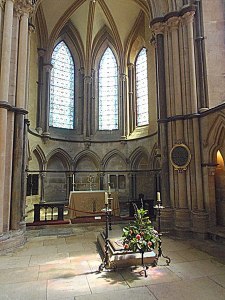St Mary le Wigford church stands next to the railway line on St Mary's Street in today's centre of Lincoln. Built during the 11th century by Eirtig. It was one of the 15 Lincoln churches that survived the Reformation: there were 52 churches until this time but many of the parishes they served were deserted or were very small. Parishes were combined and many of the redundant churches were pulled down.
The memorial stone in the church tower of St Mary le Wigford is well recorded, you can read more about it here, but I write about an interesting event that took place in the 12th century:
Henry II's coronation was in London on 19 December 1154, John Speed, the chronicler, says he was crowned at Lincoln in 1155, while Paul de Rapin-Thoyras, the French historian, describes the event as having taken place at Wickford (Wigford) in 1158. The date given by Speed is more likely to be correct as Henry probably used his second crowning as a way of securing the support of his subjects prior to his departure for Flanders, where he was guardian of the lands of Dietrich of Alsace (Deitrich asked Henry to guard his lands while he went on a crusade to the Holy Land).
The chronicler, Roger of Hoveden,(?-1201) stated that the King cautiously avoided entering the walls of Lincoln, for the ceremony, but wore his crown in Wigford, due to a widely believed prediction, that no king wearing his crown in Lincoln would have a prosperous reign.



